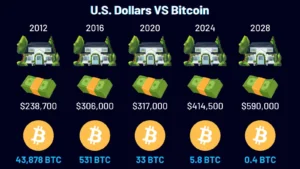Inflation vs. Deflation – The Economic Showdown
Picture your grandparents in 1970, buying a house for $50,000. Back then, that was a big chunk of change, but it was doable—a couple of years’ salary for a middle-class family. Fast forward to today: that same house, maybe with a new coat of paint, costs $500,000. What the heck happened? Inflation, that’s what. It’s the silent grinder of fiat money, where governments print more cash to cover their bills, and every new dollar makes the ones in your pocket worth less. Since 1970, the U.S. dollar’s lost over 80% of its purchasing power—your coffee’s pricier, your rent’s steeper, and that dream home feels like a mirage. This isn’t just numbers; it’s why saving feels like pushing a boulder uphill while the hill keeps growing. Fiat’s built to lose value over time, and we’re the ones stuck paying the price.
Now, flip the script with deflation—not the scary kind where economies crash, but the good kind, where an asset gets stronger. Enter Bitcoin, with its 21 million coin cap. Unlike fiat, no one can churn out more BTC to water it down; it’s scarce by design. What does that mean? As more people want it—say, to pay for groceries or stash their wealth—its value climbs. Think of it like a vintage car: only so many exist, so the price soars when demand kicks in. Here’s the house hook: imagine that $500,000 home today costs 5 BTC. In a decade or two, as Bitcoin’s value rockets, that same house might only take 1 BTC, maybe even 0.1 BTC. Not because houses got cheaper, but because Bitcoin got more valuable. That’s deflationary power—your money doesn’t just sit there; it grows, flipping fiat’s losing game into a winning one.

Let’s break down that house analogy, because it’s the heart of this showdown. In fiat world, you need more dollars every year to keep up—$50K in 1970, $500K now, maybe $5 million in 2050 if inflation keeps raging. It’s a treadmill set to “exhaustion.” With Bitcoin, it’s the opposite: you need less over time. Say you HODL 10 BTC today. As Bitcoin’s scarcity drives its value up—halvings cutting supply, adoption spiking—that 10 BTC could buy way more in the future, like that house dropping from 10 BTC to 0.1 BTC over decades. It’s not a pipe dream; it’s math meeting reality. This means savings that don’t shrink but stretch, a shot at owning something big without drowning in debt.
Why does this clash matter? Because inflation’s the enemy we all know—gas jumping from $2 to $4 a gallon, groceries eating your paycheck, the sense that you’re running in place. Fiat’s built to bleed us dry, rewarding spenders and punishing savers. Bitcoin’s deflationary edge is the antidote: it’s money that gains muscle as time ticks on, not flab. Gold hinted at this—its value held steady for centuries—but Bitcoin perfects it, digital and borderless. Fiat’s endless printing vs. Bitcoin’s ironclad limit. One’s a slow leak in your wallet; the other’s a rocket for your wealth. And that house? It’s the visual proof—fiat makes it a mountain, Bitcoin makes it a molehill.
This isn’t just economics—it’s your life. Inflation’s why your parents’ generation could buy a home young, and we’re stuck renting. Bitcoin’s deflationary promise is why your kids might not have to. It’s hope with teeth, a way to stop chasing an inflating finish line and start building a future where your money works harder than you do. Fiat’s losing the showdown, and Bitcoin’s here to win it for us all.
